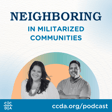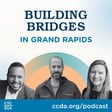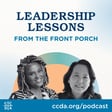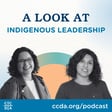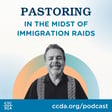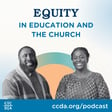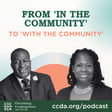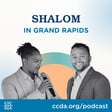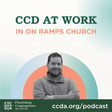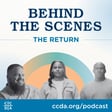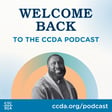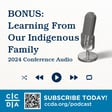Become a Creator today!Start creating today - Share your story with the world!
Start for free
00:00:00
00:00:01

Effective Successions: A Framework For Leadership Transition
Effective Successions: A Framework For Leadership Transition with Dr. Joanne Solis-Walker and Dan Walker. Hosted by former CCDA President, Ava Steffens.
Recommended
Transcript
Importance of Leadership Succession
00:00:00
Speaker
Regardless of the reason for leadership succession, it's probably one of the most important components within organizational development that most organizations, nonprofits, churches, corporate world ignore and don't recognize the value of it.
Introduction to the CCDA Episode
00:00:17
Speaker
And welcome to the CCDA podcast.
00:00:20
Speaker
On today's episode, we'll be talking about effective transitions with your host, former CCDA CEO, Ava Steffens.
00:00:29
Speaker
and featuring guests, Dr. Joanne Salisse Walker and Dan Walker, founder of Camino Road.
00:00:34
Speaker
We join them now in their conversation.
00:00:37
Speaker
As longtime CCDA practitioners and advocates, Dan and Joanne have led and successfully transitioned multiple churches, nonprofits, and educational programs.
00:00:49
Speaker
They're
Understanding Leadership Transitions
00:00:50
Speaker
the founders of Camino Road, a development company focused on leadership, culture, and praxis.
00:00:55
Speaker
Joanne has a PhD in organizational leadership and development, and Dan is completing a doctorate in urban ministry leadership.
00:01:04
Speaker
I'm eager to hear from our speakers today.
00:01:07
Speaker
And Ava, I think you've said it correctly.
00:01:10
Speaker
It's leadership transitions, it's inevitable.
00:01:12
Speaker
It happens in every organization at some point in time of the life of the organization.
00:01:18
Speaker
But the key word that you mentioned is how to do it well.
00:01:22
Speaker
Leadership transitions happened, but they don't always happen well.
00:01:27
Speaker
And it's probably, sometimes it's due to lack of planning and lack of understanding the importance of it.
00:01:37
Speaker
Sometimes it's due because there's some real core issues that need to be addressed.
00:01:42
Speaker
But regardless of the reason for leadership succession, it's probably one of the most important components
00:01:48
Speaker
within organizational development that most organizations, nonprofits, churches, corporate world, ignore and don't recognize the value of it.
00:01:59
Speaker
Yeah, and so maybe it's important for us to clarify what we mean by succession before we keep going.
00:02:04
Speaker
Abba, is that okay for us?
00:02:05
Speaker
Yes.
00:02:06
Speaker
What is leadership succession and what does leadership transition mean is, why don't you explain to that person?
00:02:15
Speaker
when we make reference to it, mostly of the literature that exists in terms of leadership succession, focuses on being able to identify what are the roles within the organization that will require the transition of a leader,
00:02:31
Speaker
And in considering that role, it's identifying and recruiting and I'll talk a little bit more about this towards towards the end of it, of what it means to then transition a leader into those significant roles within an organization so that the work continues.
00:02:46
Speaker
And so even though the primary emphasis of
00:02:50
Speaker
of succession has focused more on leaders.
00:02:54
Speaker
We also know that it's important that as a whole, when you're thinking in terms of an organization, that you also transition the organization throughout that process.
Approaches to Leadership Transition
00:03:05
Speaker
And so we think about it in terms of more of a holistic approach, which is what we're looking forward to sharing with you about that.
00:03:13
Speaker
Yeah, and then as you look into, you know, kind of the specific transition itself, not the whole succession planning, but then you come up to the transition itself and there's all kinds of different ways you can do that as well.
00:03:23
Speaker
You know, there's the model of we expect two weeks notice.
00:03:27
Speaker
The HR model.
00:03:27
Speaker
Yeah.
00:03:29
Speaker
Hey, we got two weeks notice, all hands on deck.
00:03:32
Speaker
We're in trouble.
00:03:33
Speaker
And then like the, okay, we're going to find an interim and we're going to have an interim leader.
00:03:38
Speaker
There's going to be a space.
00:03:39
Speaker
A lot of churches go this direction of needing to have an interim so that there's, especially with long-term leadership.
00:03:46
Speaker
And then there's the approach of, hey, we want to have some overlap.
00:03:50
Speaker
You know, maybe it's a month or two months or a longer term, six months overlap where the new leader comes in.
00:03:55
Speaker
The outgoing leader is still there and there's some collaboration opportunities going on, but there's some time and space in between.
00:04:04
Speaker
So lots of different approaches.
00:04:06
Speaker
And that's one of the things we'd love to know also from the folks who are listening in and watching.
00:04:15
Speaker
What other approaches are there out there?
00:04:17
Speaker
Are there different approach ideas that have come to you?
00:04:23
Speaker
So if there's an opportunity as you're looking at this, there's two questions that we've posed.
00:04:29
Speaker
And Ava, let's us talk about these two questions.
00:04:32
Speaker
You mentioned already that you've personally been through a leadership succession.
00:04:37
Speaker
And so when you think about that leadership succession, what are one, two words, a phrase that comes to your mind that describes your experience?
00:04:46
Speaker
Yeah.
00:04:47
Speaker
Well, yeah, thank you for asking.
00:04:49
Speaker
I've been part of several transitions, one from going from actually an office manager to becoming the executive director of a startup and then growing that organization for 16 years.
00:05:04
Speaker
And then having had the experience of developing a board of directors and hundreds of volunteers and over 40 staff members and all that, then transitioning that leadership to the next CEO.
00:05:21
Speaker
And those two
Challenges and Successes in Transitions
00:05:22
Speaker
were very different.
00:05:23
Speaker
One was very entrepreneurial, just learning everything there is to know about nonprofits.
00:05:29
Speaker
And the other one was a lot more well-planned and understanding some of the bigger picture and vision and how the strategic planning and having all that in place and having a strong board to help support that.
00:05:46
Speaker
they're two different places of an organizational's growth and you have to be aware of what's needed depending on the size, the scope of the organization.
00:05:58
Speaker
And I'm sure with churches, it's even more different.
00:06:01
Speaker
I'd love to hear about your experience with your work and the different types of successions and leadership transitions you've been a part of.
00:06:10
Speaker
Well, let me share two as well also, because early on for me, the first church I served in, the two words for me would be intentional and devastating.
00:06:20
Speaker
Because we were extremely intentional, probably a nine-month to a year transition out process.
00:06:26
Speaker
And then at last minute, the couple that was called to pastor the church next said,
00:06:32
Speaker
couldn't come.
00:06:33
Speaker
And so it was so intentional, but in the end became very devastating.
00:06:37
Speaker
And then my last transition out of Loving and Brevard was again a nine month transition process from announcement to me leaving very intentional and then extremely joyous, which I had been involved for 14 years, been the executive director for 12 years there.
00:06:52
Speaker
And I was prepping myself for great sadness and there was,
00:06:56
Speaker
But the way the organization responded and engaged and then moved forward in health, but also not just saying, okay, we got to focus on the new, but honored me and my transition out and brought in.
00:07:10
Speaker
I literally started telling people if I would have known it was going to be this good, I would have left a long time ago.
00:07:15
Speaker
Because it was just the way the organization handled it was so it was really joyous.
00:07:20
Speaker
It was such a such a godly experience, a holy, sacred experience for me with this last transition.
00:07:29
Speaker
I love some of our participants.
00:07:32
Speaker
Someone said it seemed force on me and others because they're not they were not invited to be a part of the transition as was needed.
00:07:40
Speaker
Something that you said, Ava, that I don't hold lightly, that I think it's super important, is that the transition is happening two ways.
00:07:49
Speaker
There's a transitioning in and there's a transitioning out.
00:07:53
Speaker
And the leader is involved, the primary leaders are involved in both of those.
00:07:59
Speaker
either transitioning out and helping to transition the next person in which is sometimes overlooked another person said that it was surprising and heartbreaking my last leadership succession experience one word tough
00:08:16
Speaker
Yeah, it can be very tough.
00:08:20
Speaker
And sometimes that's part of the journey.
00:08:23
Speaker
We have to recognize there are some real healthy approaches to leadership succession, and there's some real difficult.
00:08:30
Speaker
And this happens within the church just as well.
Biblical Examples of Transition
00:08:33
Speaker
And sometimes I think corporate world tends to handle that perhaps with a little more intentionality.
00:08:39
Speaker
than even the church and the nonprofit circle does.
00:08:43
Speaker
What do you think?
00:08:44
Speaker
I think it's important to notice.
00:08:47
Speaker
Okay, so you can transition bad and things blow up.
00:08:52
Speaker
You can also do it really, really well
00:08:54
Speaker
and end up in heartbreak.
00:08:56
Speaker
So there's an intentionality that must come into place with this, but then still, really sometimes things are outside of your control.
00:09:03
Speaker
And for some of the friends I've been talking with over the last month, that there was not a preparation, but instead the transition was handed to them.
00:09:12
Speaker
And so it's like, okay, well, all of a sudden the organization is in transition with senior leadership and they didn't know that it was coming.
00:09:18
Speaker
And so there's a lot of outside impacts to it that we, you know, really is we do the best we can before God to bring about healthy leadership succession and transition and trust that sometimes it goes really well and that effort produces fruit.
00:09:36
Speaker
Sometimes it becomes a difficult road as our friends have shared previously.
00:09:39
Speaker
heartbreaking, tough, other issues that we just, we have to trust God through that and keep pressing in, keep doing what is right, trusting him, being honest with others through the difficulty and keep pressing forward.
00:09:52
Speaker
But what we're really talking through today for the rest of the time is what is some biblical examples and then what's a framework we can look at to do the best we can with what God's been giving us in these transitions.
00:10:05
Speaker
Yeah, and it's interesting what I'm hearing also is the importance of realizing that leadership transition is not just about the top leaders, but how does it affect everyone involved in the organization.
00:10:19
Speaker
I'd love
Experiences in Leadership Transition
00:10:20
Speaker
to hear what your experience is coaching through leadership transitions and how widespread is that across a church or an organization?
00:10:33
Speaker
And this is interesting because just to add to the conversation, the fact that I experienced effective succession.
00:10:43
Speaker
So I experienced leadership transition.
00:10:46
Speaker
And for Dan, it was a principal.
00:10:48
Speaker
So it was something he was taught.
00:10:50
Speaker
And for me, it was something that it was modeled.
00:10:53
Speaker
So for me, it was modeled.
00:10:55
Speaker
in a healthy and unhealthy way.
00:10:57
Speaker
So I've experienced both.
00:10:59
Speaker
I was a part of a church at a very young age where the transition was a really tough transition.
00:11:07
Speaker
There was wrong decisions made within the church and the pastor had to exit immediately and the congregation had to wrestle with what that meant and the body had to wrestle with the implications of that.
00:11:20
Speaker
And then I experienced my first real experience in a nonprofit organization.
00:11:26
Speaker
I worked with this amazing leader that modeled what I considered to be a perfect approach to transitioning out and implementing not only the leadership, but the processes that then would continue to carry forth the vision without limiting the growth of the nonprofit.
00:11:45
Speaker
And so the way that we've experienced
00:11:48
Speaker
this is something that we take into consideration.
00:11:52
Speaker
So for Dan, he learned it in military school.
00:11:56
Speaker
It was something that he had in leadership development.
00:12:00
Speaker
So from a principal perspective, in terms of understanding it,
00:12:04
Speaker
That was him from an experiential perspective.
00:12:08
Speaker
That was me.
00:12:08
Speaker
Those two things, bringing those two things together is then what has allowed us or what God has gifted us with the opportunity to then look at effective succession from a more holistic approach taken into consideration.
00:12:25
Speaker
Various factors that should be included, which is the model that we use when we're coaching and consulting for effective successions.
00:12:34
Speaker
And some of the blessing that we've had is not only to walk with people here in the United States, but also internationally.
Lessons from Moses to Joshua
00:12:42
Speaker
Latin America, taking into consideration that there's some contextualization that has to happen to these bits and pieces, right?
00:12:48
Speaker
And recognizing that because we know that not all leadership transitions are the same, that you have to be able to treat each one for what it's worth, for what that experience entails.
00:12:59
Speaker
And then you have to be able to coach and journey with the church, with the nonprofit, with the leader in a way that is explicit and applicable to their reality.
00:13:12
Speaker
That's good.
00:13:13
Speaker
And it really was for us both early on where we brought in consultants to help us do transitions.
00:13:18
Speaker
And then now we are walking in and really, what is the value of that?
00:13:24
Speaker
An outside perspective, helping give a very structured approach to what seems very easy.
00:13:29
Speaker
Find the new leader, transition the mantle of authority to them.
00:13:33
Speaker
It's all good.
00:13:33
Speaker
And you start asking questions.
00:13:35
Speaker
And next thing you know, which right now we're working through what may end up becoming a two-year leadership succession process, that's exciting to see that kind of intentionality and purpose and effective holistic model going through.
00:13:51
Speaker
It has to be grounded in our Christian understanding.
00:13:55
Speaker
It can't exist apart from our biblical understanding.
00:14:02
Speaker
Hi, I'm Lorenzo.
00:14:03
Speaker
What I love about CCDA is being connected to so many amazing leaders across the country.
00:14:09
Speaker
Welcome to the CCDA podcast.
00:14:14
Speaker
I want to hear about your biblical examples because I also hope that you intertwine in there.
00:14:22
Speaker
You've mentioned a holistic approach model and I think you're going to be leading us into that.
00:14:29
Speaker
So I'm excited to hear what you have to share with us.
00:14:31
Speaker
And that's exactly what I'm trying to say.
00:14:34
Speaker
Our holistic approach begins with that spiritual grounding.
00:14:38
Speaker
This will be and I and I really, really am convicted about this, but this will be harder.
00:14:45
Speaker
This will be more difficult if we are not in tune or cultivating a relationship with the Holy Spirit throughout the process to give us the discernment and the guidance and even the ability to see the things that are not visible to us.
00:14:59
Speaker
Because it's a process and no one is an expert at transitioning because there's so many variables.
00:15:07
Speaker
And so really for us, this holistic approach is grounded particularly on this biblical starting point and then branching out into the praxis of what that looks like.
00:15:20
Speaker
So I'd love to talk about a biblical example.
00:15:23
Speaker
We're just going to quickly run through the leadership succession from Numbers to Judges.
00:15:28
Speaker
Just the beginning of Judges, the end of Numbers.
00:15:30
Speaker
But really, it's two folks.
00:15:32
Speaker
It's from Moses to Joshua.
00:15:34
Speaker
I just finished reading Deuteronomy.
00:15:36
Speaker
Awesome.
00:15:38
Speaker
Just this morning.
00:15:39
Speaker
So you'll have time in.
00:15:42
Speaker
I love it.
00:15:43
Speaker
Perfect timing.
00:15:44
Speaker
Perfect.
00:15:44
Speaker
And while we do that, Joanne mentioned for the chat, I would love to hear from you.
00:15:48
Speaker
What are the biblical examples that come to your mind about leadership succession as I talk through just a few of the things that stand out from Moses and Joshua as a biblical example?
00:16:00
Speaker
Yeah.
00:16:00
Speaker
And this is important because we often think that leadership succession comes from the business world.
00:16:06
Speaker
And obviously not to minimize that, my area of expertise is leadership.
00:16:11
Speaker
And so I am all kudos for that.
00:16:14
Speaker
And often social sciences is very much separated from the theological frameworks.
00:16:19
Speaker
And these two things work hand in hand.
00:16:21
Speaker
The Bible is such a practical tool.
00:16:23
Speaker
But some of the amazing examples of the good and the not so good come from Scripture themselves.
00:16:29
Speaker
This is a wealth of information for all of us that we should not avoid, but we should turn to in those processes.
Principles and Frameworks for Succession
00:16:39
Speaker
So chime in a few of your examples of leadership as I share just a little bit about Moses and Joshua.
00:16:45
Speaker
And so this is the end of Numbers all the way through Judges.
00:16:49
Speaker
And at the end of Numbers, it's Numbers chapter 27.
00:16:52
Speaker
What happens is God tells Moses, go up on the mountain, look into the promised land, and then you're going to be taken up.
00:17:00
Speaker
then you're going to die.
00:17:02
Speaker
He says, you're not going to go in, but you're going to be able to see it.
00:17:05
Speaker
And so Moses responds with like, okay, I have one thing that I'm asking of you, God.
00:17:10
Speaker
And I'm like, okay, here it comes.
00:17:12
Speaker
He's going to, you know, give me a second chance.
00:17:14
Speaker
It was an accident.
00:17:14
Speaker
Let me in.
00:17:16
Speaker
One thing that he asks is says,
00:17:18
Speaker
God, would you appoint the next leader so that the people are not without a guide?
00:17:25
Speaker
That's his, God says, you're going to die and you're not going to get into the promised land.
00:17:29
Speaker
And his response is appoint somebody for the people.
00:17:33
Speaker
It's amazing to me.
00:17:35
Speaker
If more leaders were so intentional that the thing that matters is God, God, do something beyond when I leave, keep the leadership going.
00:17:44
Speaker
And so God says, I have seen the spirit of leadership on Joshua.
00:17:50
Speaker
And so he tells Moses, go get Joshua, bring him before the people, get the priest Eliezer, and have a spiritual gathering.
00:18:00
Speaker
And everybody lay hands on Joshua and anoint him as the next leader of Israel.
00:18:06
Speaker
And then very interesting, God tells Moses, give some of your leadership anointing to Joshua.
00:18:14
Speaker
It's not all of it.
00:18:15
Speaker
Yeah.
00:18:16
Speaker
So this happens where he gives some of his leadership anointing.
00:18:18
Speaker
And then from there, they go on and Moses is still leading, but now Joshua is leading beside him with a portion of his mantle of leadership.
00:18:26
Speaker
And then as you get into Deuteronomy, time is coming to the end with Moses.
00:18:31
Speaker
And so they come together in a public setting again.
00:18:34
Speaker
And Moses says, Joshua, be strong and courageous.
00:18:37
Speaker
And then God says to Joshua, be strong and courageous.
00:18:40
Speaker
The mantle is fully passed on to Joshua and
00:18:43
Speaker
And Moses goes on to pass on.
00:18:47
Speaker
Beginning of Joshua, now the book of Joshua, Joshua is now in full leadership.
00:18:52
Speaker
He has the full authority of God, the spiritual anointing, and things are going great.
00:18:56
Speaker
They're working through the land.
00:18:58
Speaker
And Joshua lives out his days.
00:19:00
Speaker
But at the end of Joshua, this is when you have Joshua's big transition.
00:19:04
Speaker
And this is the text where he says, hey, y'all got a decision to make.
00:19:09
Speaker
Are you going to serve the Lord or not?
00:19:10
Speaker
And then the famous text, many of us know, but as for me and my house, we will serve the Lord.
00:19:16
Speaker
And the people respond, we're serving the Lord also.
00:19:18
Speaker
You know, and I'm thinking, man, here it comes.
00:19:21
Speaker
Joshua is about to pass the mantle on too.
00:19:24
Speaker
And he says, y'all better go serve the Lord.
00:19:27
Speaker
Okay, bye.
00:19:28
Speaker
And he sends them home.
00:19:31
Speaker
There's no mental transition to another leader.
00:19:34
Speaker
And then scripture is clear at the end of Joshua and the beginning of judges, while Joshua dies and while his peers, the other elders of his generation lived, the people followed the Lord.
00:19:46
Speaker
As soon as his peers died,
00:19:49
Speaker
The people turned to evil ways, turned away from the Lord.
00:19:53
Speaker
And so, you know, to me it's like, what a juxtaposition of Moses' intentionality and how the people continued following in the ways of the Lord versus Joshua, who did so much right and really so powerful a call, serve the Lord, now go do it.
00:20:09
Speaker
But the leadership succession was not there, and the people turn.
00:20:14
Speaker
And really from there, Joanna, it was, you know, then it goes on and says, the Lord raises up a judge, and the people turn back to the Lord.
00:20:21
Speaker
The judge dies, the people turn away from the Lord.
00:20:25
Speaker
And it is one thing.
00:20:27
Speaker
Turn back and forth, back and forth.
00:20:29
Speaker
As God raises up, it's good.
00:20:31
Speaker
As the leader dies, they turn.
00:20:34
Speaker
It is so powerful section of scripture to emphasize this, the importance of good leadership succession.
00:20:40
Speaker
So what's the lesson we learn here?
00:20:43
Speaker
Great.
00:20:45
Speaker
And that's what fuels our approach to this.
00:20:48
Speaker
So there's people, not just the individual, not just the leader that is transitioning in or the leader that is transitioning out, but there's the people.
00:21:00
Speaker
There's also the mission, right?
00:21:02
Speaker
The spreading of the good news was so essential and it is so evident in the passing on from one king to another, what happens when it is passed on and what happens when it's not.
00:21:15
Speaker
And so each of our organizations, regardless of what we are, a church or a nonprofit or we're in the corporate world, it doesn't matter.
00:21:23
Speaker
There's people, there is a vision, there is a work that has been done.
00:21:29
Speaker
that needs to take into consideration, that needs to be taken into consideration.
00:21:33
Speaker
And so when Joshua doesn't pass that on, then the people are at a loss.
00:21:39
Speaker
The vision is at a loss.
00:21:40
Speaker
And so you see it sometimes that when a leader transitions out of their role,
00:21:46
Speaker
and completely dismisses the vision and the mission of the organization, then it takes on a new life.
00:21:54
Speaker
And so I'll pause there to say, you know, there are some times where that's exactly the will of God, where that's exactly what is necessary, where the organization needs to reinvent itself because it has reached its capacity where it's at and it needs to rethink itself.
The Four-Phase Succession Plan
00:22:12
Speaker
how it's going to fulfill the mission and how to redefine the work that they have been doing.
00:22:18
Speaker
Often what happens, particularly within churches, you get the model of a new pastor comes in and everyone resigns.
00:22:28
Speaker
And then everyone that has been serving resigns.
00:22:31
Speaker
And then the new pastor comes in with a new vision and a new team of people.
00:22:36
Speaker
And so it is part of the reality, right?
00:22:39
Speaker
And so how you manage that and how you manage a different model of transition is going to be important.
00:22:48
Speaker
And so what our emphasis is, is that you take into consideration the
00:22:52
Speaker
what we call four phases.
00:22:54
Speaker
So we have four phases to the actual leadership succession plan.
00:22:58
Speaker
And we believe that even though sometimes you only have two weeks to do the transition, that if you have the capacity to plan, it's called the succession plan on purpose.
00:23:12
Speaker
You plan it, you roll it out, you invest into being able to create that succession plan.
00:23:19
Speaker
And let me say just one more thing about the biblical examples before we go in.
00:23:23
Speaker
And so I want to be clear.
00:23:24
Speaker
It's easy sometimes to say, okay, here is the prescription for leadership, transition, leadership succession.
00:23:31
Speaker
It's there in the Bible.
00:23:32
Speaker
We have to do it this way.
00:23:33
Speaker
But the truth is there is prescriptive, like,
00:23:37
Speaker
There are prescriptive, obey, honor your father and mother, right?
00:23:41
Speaker
But then also there's other texts that are descriptive, right?
00:23:44
Speaker
And so this is more of a descriptive, it describes what I view as a very healthy leadership succession process.
00:23:52
Speaker
What we've done in building this framework and trying to put it, is putting these options in there for the discernment to take place to say, should we have an overlap like Moses did with Joshua?
00:24:04
Speaker
So it's a descriptive opportunity where we take these and see the laying on of hands of the new leader, the passing on of a portion of the authority that then later becomes the fullness.
00:24:14
Speaker
And so it gives the organization a time, all beautiful things, not things you have to do that God says you have to do it this way,
00:24:21
Speaker
but as an opportunity to build a holistic effective succession opportunity for our organizations.
00:24:28
Speaker
We see him, excuse me.
00:24:29
Speaker
Go ahead, Abel.
00:24:31
Speaker
Excuse me, I saw one of our attendees on the chat say Jesus and his apostles too as another example of leadership succession planning.
00:24:43
Speaker
I love that.
00:24:44
Speaker
It'll be interesting to see how that fits into your model here.
00:24:49
Speaker
I do want to remind our attendees that if you have a question, if questions come up as you're listening, feel free to pop those into the chat and we will review those at the end.
00:25:01
Speaker
So sorry for interrupting, but yeah.
00:25:04
Speaker
No, you're good.
00:25:05
Speaker
And actually, that's one of my questions.
00:25:06
Speaker
I don't know if any of our attendees are going through a leadership succession right now or experiencing some kind of transition.
00:25:15
Speaker
And we'd love it if you use the chat to be able to say, hey, count me in.
00:25:18
Speaker
I'm there right now.
00:25:20
Speaker
And to post whatever you want in reference to what your experience is at this moment.
00:25:25
Speaker
Yeah.
00:25:26
Speaker
And so with that as a framework, and I'm gonna get back to what Daniel Suarez has said about Jesus and the apostles, because that is part of the framework within itself.
00:25:38
Speaker
And so when we look at the framework that we have designed, we're looking at three main components, the different phases, the people, and the processes that this entails.
00:25:52
Speaker
And so the different phases,
00:25:54
Speaker
as in there are different timeframes that have to occur and that sometimes we find ourselves in different timeframes.
00:26:02
Speaker
And Dan will go into this, but like pre-planning the preparation for the leadership transition, the actual transition and the assessment.
00:26:11
Speaker
Now I'll only mention them briefly and he'll share a little bit more about it, but I mentioned them because we don't want you to think about leadership transition as snap, my fingers snap,
00:26:22
Speaker
and this is going to happen and magically everything is going to fall in place.
00:26:26
Speaker
That's not necessarily what we call a holistic approach to it.
00:26:30
Speaker
And even though time is of essence, right, it is important, we still believe that if you only have a very short timeframe that it is important to consider that there are different phases, that different people are involved,
00:26:45
Speaker
And that there are processes that really could help make this a holistic and healthy approach because that's what we're after, right?
Emotional and Cultural Aspects of Transition
00:26:53
Speaker
Even if it's a short process, we're after a long-term organizational health.
00:26:59
Speaker
We want health.
00:27:01
Speaker
And so these are the processes that, these are the phases, the framework that we have been using in order to be able to help people walk through this.
00:27:09
Speaker
Why don't you share a little bit about it?
00:27:11
Speaker
Yeah, so let me just explain those four phases a little bit and then we'll talk about the other pieces that are involved.
00:27:17
Speaker
So the first one is pre-planning.
00:27:18
Speaker
That is the glorious stage when nobody knows a leadership succession transition is gonna take place.
00:27:23
Speaker
I'm not leaving.
00:27:24
Speaker
Everybody's in place, everything's good.
00:27:26
Speaker
and we're just moving forward.
00:27:27
Speaker
Now is the time to prepare, right?
00:27:29
Speaker
Now's the time for succession planning.
00:27:31
Speaker
And then there's the time when we find out, yes, one of our leaders is gonna be transitioning, but it actually hasn't happened yet.
00:27:38
Speaker
And so that's the preparation phase where we're actually preparing for the transition to happen.
00:27:43
Speaker
And then of course, the third stage is the actual transition.
00:27:45
Speaker
So whenever that's, it's a day or a longer period of time, that period of phase of the actual transition happening.
00:27:52
Speaker
And then the last one, which again, like the first easily ignored,
00:27:56
Speaker
Before you know you need to prepare, it's hard to.
00:27:58
Speaker
And then also after the transition, we're all busy running and it's easy to miss that final phase of assessment where you're able to look back and review and kind of redirect.
00:28:08
Speaker
So those are the four phases.
00:28:09
Speaker
And then what kind of people need to be involved in that?
00:28:13
Speaker
And I'll make one short comment about the phases, especially that first one, because I have a huge passion for that very first phase.
00:28:24
Speaker
Because most of the people here, we just asked a question about who may be officially in a process of a transition.
00:28:30
Speaker
And most of the responses, there haven't been a lot of responses.
00:28:34
Speaker
There is a response from Janet, which we appreciate.
00:28:37
Speaker
But because you're not in a leadership transition, this is the time to think about
00:28:42
Speaker
leadership transition, because we won't all exist in our roles.
00:28:47
Speaker
And so the perfect time to begin to plan for leadership transition, even if you plan on being there for 15, 20 years, is now.
00:28:55
Speaker
It is now.
00:28:56
Speaker
This is the perfect opportunity to be able to do it.
00:28:58
Speaker
And when you're thinking about the different phases that are involved in with leadership transition, then it's also important to consider the people.
00:29:07
Speaker
there's primary leader.
00:29:08
Speaker
There are the two, the leader that is moving in, the leader that is moving out.
00:29:13
Speaker
And yes, them and their families, they're very important to this transition, but they're not the only people involved in the transition.
00:29:21
Speaker
There's board members, there's organizational members, there's people that have been invested, for instance, in the congregation.
00:29:29
Speaker
My experience was that
00:29:30
Speaker
when that leadership transition had to take place and there was a good reason why my pastor needed to leave the church.
00:29:38
Speaker
However, there was very little conversation taking place as to how we regroup, how we redefine, how we hold each other's hand throughout the leadership transition.
00:29:52
Speaker
And so in leadership transitions is not only in terms of the practical and processes that need to take place, there's also an emotional component that comes attached to who people are.
00:30:03
Speaker
So emotional intelligence is important during that time.
00:30:06
Speaker
Cultural intelligence is important.
00:30:08
Speaker
understanding the way that the community is going to respond is not something you want to overlook because our aim is organizational health, long-term organizational health, way beyond our existence.
00:30:22
Speaker
And we can't move forward with leadership transition either with ignoring that there are other constituents that may not be members of the congregation, that may not be embedded within the nonprofit,
00:30:34
Speaker
but they're the people that we serve outside of the church or outside of the nonprofit.
00:30:39
Speaker
They are the partners.
00:30:41
Speaker
They are those
Processes in Leadership Succession
00:30:42
Speaker
who are not necessarily involved in the decision-making process, but affected by the decision-making process.
00:30:50
Speaker
So we've got the four phases and then the three different kinds of people that Joanne just talked about that we need to take in consideration.
00:30:56
Speaker
And then really as we looked at it, we've got three different kinds of processes that should be considered at each of those phases.
00:31:01
Speaker
So first, what needs to be discerned?
00:31:03
Speaker
And then second, what do we need to communicate and to who?
00:31:07
Speaker
And then finally, what are the actions we need to take at each stage?
00:31:10
Speaker
And so careful thought about each of those is important to build that holistic effective plan.
00:31:15
Speaker
And so let me just walk through those four phases with a few of the things that come involved in each of them.
00:31:20
Speaker
And so the first one is the pre-planning stage, which could be anywhere from a few months to years, depending on how long that existing leader's in place.
00:31:29
Speaker
The danger, which we already talked about, is that succession is not important until it is.
00:31:35
Speaker
when it comes upon you.
00:31:37
Speaker
And so this is the time where you have to be very intentional.
00:31:40
Speaker
And then looking there, you really have this focus on being able to look at the long-term health of the organization.
00:31:48
Speaker
You're not immediately focused on who are we replacing, more so it's how are we putting a succession plan in place that's gonna focus on the long-term health of the organization.
00:31:56
Speaker
So it's a great time
00:31:58
Speaker
in that pre-planning phase to be able to do some of the more healthy, not the demanded kind of planning for succession.
00:32:06
Speaker
And then the second stage, that second phase is the preparation phase when you know a leadership transition is taking place.
00:32:13
Speaker
This could be anywhere from a few months to a few years.
00:32:16
Speaker
There's some long-term leaders who say, you know what, I've got three years left.
00:32:19
Speaker
There's others who say, I've got two weeks left.
00:32:22
Speaker
And so that preparation phase can, can,
00:32:26
Speaker
very widely as well.
00:32:28
Speaker
And in this phase, you're looking at organizational assessment.
00:32:31
Speaker
So before you find that next leader, it's great time.
00:32:34
Speaker
Okay, you know what transition's coming.
00:32:36
Speaker
You look at either the group that that leader was in charge of or the organization as a whole, depending on who is transitioning, and kind of assess and look, okay, are we trying to find the same leader or is there some discernment we need to bring in a different leader for the next
00:32:50
Speaker
season that we're coming to.
00:32:52
Speaker
And really, then it's a time to come back to the approach, kind of really hone in on what kind of approach is it going to be the interim?
00:32:58
Speaker
Is it going to be the overlap?
00:33:00
Speaker
Is it going to be a transition?
00:33:01
Speaker
All of those things are important.
00:33:03
Speaker
And of course, in this time, you have to do the search and selection as well.
00:33:07
Speaker
So coming up to that, you can't transition until you found the next person, right?
00:33:12
Speaker
And then the last
Holistic Transition Framework Summary
00:33:13
Speaker
two phases I want to touch on, the transition phase, and that's the phase where the actual transition takes place.
00:33:18
Speaker
This could be anywhere from a day to six months or longer, depending on whether there's an overlap.
00:33:24
Speaker
In this, what is very important is for the man to be passed from the outgoing leader to the incoming leader.
00:33:31
Speaker
I've heard so often it is the incoming leader's responsibility to find out how to grab that, you know, to get a hold of that.
00:33:37
Speaker
Well, I want to say to you, I believe it is the outgoing leader's responsibility.
00:33:40
Speaker
responsibility, the incoming leader's responsibility, and the organization as a whole to be able to make sure that new leader has received the full mantle of authority and a healthy way to be able to lead from there.
00:33:52
Speaker
And then, as I mentioned, that last phase is really assessment and could be three months, maybe six months afterwards, where you really do an overview of the whole process
00:34:01
Speaker
succession transition process and ask yourself what's gone well, what didn't go well, what do we need to change for the future and how maybe we were trying to go straight but our efforts have been leading us, how do we make an early course correction with that new leadership to be able to continue to move forward.
00:34:18
Speaker
So that's the overall of the framework.
00:34:21
Speaker
Excellent.
00:34:22
Speaker
Wow.
00:34:22
Speaker
A lot there and a lot I can imagine unpacking each portion of that.
00:34:28
Speaker
We'll be right back.
00:34:29
Speaker
But first, a word from our sponsor.
00:34:31
Speaker
Hello, I'm Paul Miles, president and CEO of We Raise Foundation.
00:34:36
Speaker
We Raise invests in people and organizations that serve at the intersection of poverty, violence and inequality.
00:34:42
Speaker
We start by acknowledging that change begins with we.
00:34:45
Speaker
We are in this together.
00:34:47
Speaker
And it's going to take our love and our compassion and dedication to solve the problems facing communities today.
00:34:54
Speaker
We invite you to be part of that with us and encourage you to visit WeRaise.org to find out how you can become involved and be a partner with WeRaise.
Developing a Diverse Leadership Pipeline
00:35:05
Speaker
One of the questions that comes up a lot is how do we develop a diverse leadership pipeline?
00:35:12
Speaker
This is my favorite question, Abba.
00:35:15
Speaker
OK.
00:35:18
Speaker
Because I still think there's some basic principles that you want to consider.
00:35:22
Speaker
And this is where I feel it's important to ask about how we are inclusive in this portion.
00:35:30
Speaker
So you still want to do that assessment.
00:35:33
Speaker
You really want to do an assessment on who you are as a nonprofit, as a church, as a CCD.
00:35:43
Speaker
Who are you?
00:35:44
Speaker
What is the vision?
00:35:45
Speaker
It's a good time to remind yourself of the work that you're trying to accomplish.
00:35:50
Speaker
The first step that I recommend is look at your strategic plan.
00:35:54
Speaker
Where are you going?
00:35:55
Speaker
And if you don't know, before you start thinking about who you're going to transition in, it's a perfect opportunity to just go back and assess those things.
00:36:05
Speaker
Check and balance is what I call it.
00:36:07
Speaker
Just make sure that you're really doing what you said you were going to do as a ministry.
00:36:13
Speaker
And in the process of it, then you take a peek at what are the positions that you're trying to plan for, that you're trying to
00:36:21
Speaker
to be ready for whenever a leadership transition takes place.
00:36:25
Speaker
And is the job description accurate?
00:36:27
Speaker
Is it current?
00:36:28
Speaker
Is it applicable?
00:36:30
Speaker
Is it really responding to the needs of the organization that you're in charge of?
00:36:34
Speaker
So that first, for me, the first step is taking that assessment, that check and balance, and taking a peek at it.
00:36:41
Speaker
Now, here's where I'm going to add this portion.
00:36:44
Speaker
You have to, please, please, please, I beg of thee,
00:36:48
Speaker
Take a peek at your organizational culture.
00:36:53
Speaker
So you run the risk that if your staff, if your leadership, if your board, if there is no intentionality to be inclusive of different cultural backgrounds, of different languages,
00:37:08
Speaker
then creating a position for a person of color is often just an act of tokenism.
00:37:16
Speaker
And when it is not, if you don't rethink or put into place the type of bring together the group of people that are really going to help that person of color, then it's contradictory to what you're trying to do.
00:37:33
Speaker
So diversity is not counting numbers.
00:37:35
Speaker
Not that numbers are an important friends.
00:37:37
Speaker
Okay, so, so I come from more of an academic educational background and I always say this, I want students from different cultural backgrounds and different countries and I from different languages.
00:37:50
Speaker
But if the entire leadership of the institution does not reflect that what kind of service am I offering the students
00:37:56
Speaker
right i have to be mindful of then of making sure that there's there's a contextualization that is taking place in admissions in marketing in my retaining of students all of that matters so this step for me is really the most important because if you're taking a peek at your organizational culture and you're taking a peek on how that is really modeled and expressed
00:38:21
Speaker
then it's going to tell you a ton of things.
00:38:23
Speaker
Now hear me.
00:38:23
Speaker
I am not a hit you upside the head prophetic speaker that I'm going to sit here and critique anyone.
00:38:31
Speaker
What I am saying is regardless of where you find yourself at, let that be your starting point.
00:38:36
Speaker
Where do you want to be if you want to be an interculturally developed Institution then what does that mean?
00:38:43
Speaker
Where are you so that you become that and that all needs to happen during this this?
00:38:50
Speaker
phase what I call the most important phase of it once that's determined the second tidbit from from my perspective is that you go into the recruiting and the inviting you've developed a job description now There's two things that I have to say about this one
00:39:05
Speaker
leadership development there's going to be one type of there's going to be a type of person that you're going to try and recruit and invite that needs to be developed that has a lot of qualifications that has a lot of capacities and just needs to be groomed needs training needs modeling to take place and will follow in the footsteps but there's also a second person that you want on board depending on where your institution is at
00:39:30
Speaker
And that's the leader that's going to develop the organization, that is going to invest.
00:39:35
Speaker
So we say often that if I am walking into an institution that I have already gone through the experience in the train, I don't need to be developed in those areas.
00:39:49
Speaker
I just need the spaces.
00:39:51
Speaker
And I need the opportunity to be the leader and invest into the existing leadership, even those that are above me, right?
00:39:58
Speaker
And that's just as much leadership development than the other aspect of leadership development is.
00:40:05
Speaker
And then there's some leaders who are developed and equipped to be able to assume some key leadership positions that need the space to be able to be of influence.
00:40:17
Speaker
Does that make sense, Abba?
00:40:18
Speaker
Yeah, it does.
00:40:19
Speaker
It really does.
00:40:20
Speaker
You really need to know.
00:40:23
Speaker
You have to be aware of who your leaders are and where they are in their developmental stage and where the organization is in its developmental stage in order to tie those together appropriately so the organization, the church, the community can flourish.
00:40:42
Speaker
It really makes a lot of sense.
00:40:45
Speaker
We are getting a couple of questions here.
00:40:49
Speaker
So as you wrap up, let me know because I'd like to ask some of those questions that we're getting or be able to.
00:40:57
Speaker
One more comment for me on the diverse pipeline.
00:41:02
Speaker
And when we talk about assessment, it's easy, you know, most of us, if we've been in organizational leadership for any period of time, we've gone through organizational assessment.
00:41:10
Speaker
But particularly when you're talking about diversifying the organization and diversifying the leadership pipeline, it's important to use one of many cultural competency assessments that really focus in because, you know, a lot of us feel like we're
00:41:26
Speaker
We're doing a great job.
00:41:27
Speaker
Diversity, equity, inclusion.
00:41:28
Speaker
We're awesome.
00:41:30
Speaker
And then we start looking at it with a different set of eyes, a validated assessment model, and start to find out, hey, there's some stuff going on beneath the surface that we don't know about.
00:41:41
Speaker
And so what we are using is the IDI.
00:41:44
Speaker
It's the Intercultural Development Inventory.
00:41:46
Speaker
It's an assessment that's validated that can really take a look at the organization as a whole.
00:41:51
Speaker
and really be both clear in its assessment and prescriptive in how to build that diverse organizational culture that Joanne was talking about a little bit ago.
00:42:01
Speaker
And so we'd highly encourage, there's multiple models using one of those assessment models to be able to get some more objective insight into the culture.
00:42:11
Speaker
And in response to the question that Nellie is making, one of the attendees is asking, should you or do you involve your HR team in the process?
00:42:19
Speaker
Yes and yes.
00:42:21
Speaker
It is very important the HR person plays a key role in anything that has to do with leadership development.
00:42:28
Speaker
It's also important that if that is not a person of color that can understand the importance of diversity, then that person should
00:42:36
Speaker
receive training, go through the processes, know where they're at in the taxonomy of cultural responsiveness, be able to recognize where they're at in order to continue to develop.
00:42:46
Speaker
And the other important piece of HR, which is part of developing a diverse leadership pipeline, is that the development requires training, that it requires creating those pathways, that there's an investment, and that the HR office is extremely important,
00:43:02
Speaker
plays an important role in that taking place.
00:43:07
Speaker
And so HR doesn't disappear from that.
00:43:10
Speaker
I would say HR is involved not only in the development of the leader, but in the growth process, even after that leader has been recruited, trained and hired in the releasing of it as well.
Resources and Conclusion
00:43:24
Speaker
There's one more thing I wanna end with in terms of that.
00:43:28
Speaker
part of the model that is used is that, you know, you journey together with the incoming leader and then the leader that has been in place, it serves as that role model, as that guide.
00:43:45
Speaker
and then often begins to occupy a place where they work together in a shared leadership posture.
00:43:52
Speaker
And then the incoming leader holds more of a leadership drive and the outgoing leader steps back and allows that leader to function.
00:44:03
Speaker
And then the last where it's, man, let that leader go, let that leader bring into fruition what you have invested into that leader.
00:44:12
Speaker
And so all of this is part of why we say this takes all of us.
00:44:17
Speaker
This takes all the people.
00:44:18
Speaker
It doesn't eliminate someone from the process.
00:44:21
Speaker
But if we want diverse leadership pipelines, we have to be intentional about understanding what that means and being able to equip and prepare.
00:44:31
Speaker
and be able to recognize that sometimes it's the organization that needs the leadership development and needs to call out on leaders that have been developed so that they are of influence into the processes and the systems as well.
00:44:44
Speaker
Yeah, and with that, we've mentioned a few resources that we might be able to pull up here.
00:44:47
Speaker
And one of those, Alvin Sanders in 2016 gave a workshop at the CCDA National Conference.
00:44:53
Speaker
He gave it on creating a leadership pipeline.
00:44:55
Speaker
That's available at CCDA.org.
00:44:57
Speaker
Just go into the store and you can search for it.
00:45:00
Speaker
Search by leadership pipeline.
00:45:01
Speaker
You'll be able to pull that up and listen to the whole live.
00:45:04
Speaker
There it is.
00:45:05
Speaker
Listen to the whole live recorded workshop.
00:45:10
Speaker
Yep.
00:45:11
Speaker
2016 conference, really the whole thing was on that leadership pipeline and he does a great job going into depth about finding leaders and how to make that transition of building up that leadership pipeline.
00:45:25
Speaker
So I'd really recommend that.
00:45:26
Speaker
And then there's a few books that have been influential to us as well in where we are, how we got to this place as well too that are there.
00:45:39
Speaker
And thank you for listening.
00:45:40
Speaker
Big thanks to Ava Steffens, former CCDA CEO, leading us through this conversation with Dr. Joanne Salise Walker and Dan Walker of Camino Road about effective successions, a framework for leadership transition.
00:45:54
Speaker
Tune in next time as we hear from Jesse Chang, Ra Wang, and Tim Yee about urban gardens as community assets.
00:46:01
Speaker
Hello, I'm Paul Miles, president and CEO of We Raise Foundation.
00:46:05
Speaker
We Raise invests in people and organizations that serve at the intersection of poverty, violence, and inequality.
00:46:11
Speaker
We start by acknowledging that change begins with we.
00:46:15
Speaker
We are in this together, and it's going to take our love and our compassion and dedication to solve the problems facing communities today.
00:46:23
Speaker
We invite you to be part of that with us today.
00:46:26
Speaker
And encourage you to visit WeRaise.org to find out how you can become involved and be a partner with WeRaise.
00:46:34
Speaker
Thank you for listening to the CCDA podcast.
00:46:37
Speaker
Don't forget to subscribe on Apple Podcasts, Spotify, or wherever you listen to podcasts.
00:46:43
Speaker
This podcast is produced by Dan Portnoy in association with Scott Overbeck.

